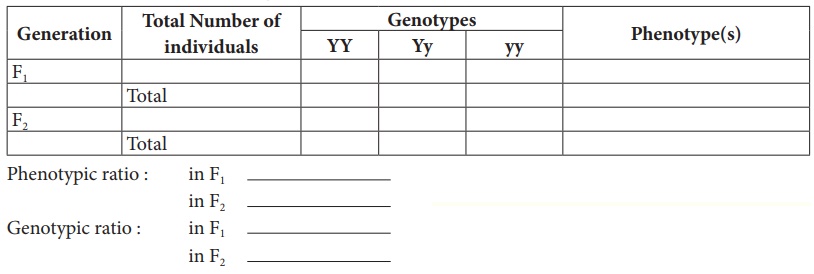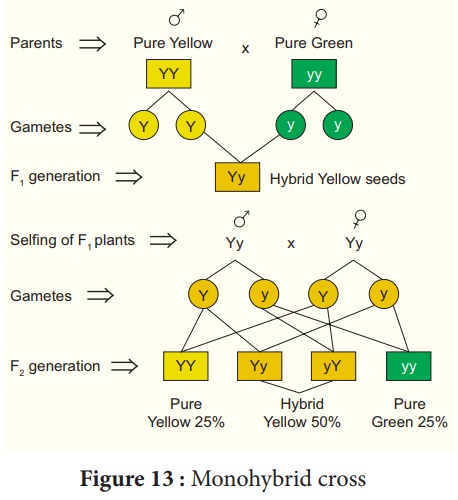Solving the Problems | Botany Practicals - To verify MendelŌĆÖs Monohybrid cross | 12th Botany : Practicals
Chapter: 12th Botany : Practicals
To verify MendelŌĆÖs Monohybrid cross
Exercise: To verify MendelŌĆÖs Monohybrid cross
NOTE: Student have to work in
pairs to perform this experiment and record the data in the observation
and record note book with the help of the teacher.
Need not consider this
Monohybrid cross experiment for Board Practical Examination.
Aim:
To verify MendelŌĆÖs
Monohybrid cross.
Principle:
When two pure lines with
contrastingtraits of a particular character (phenotype) are crossed to produce the
next generation (F1generation), all the members of the progeny are of
only one phenotype, i.e. of one of the two parents. The phenotype that appears is
called dominant and the one that doesnot appear is called recessive. When the F1
plants are selfed, the progeny i.e. the F2 generation, is in the
ratio of 3 dominant : 1 recessive (┬Š : ┬╝ of 75% : 25%). This reappearance of
the recessive phenotype in F2 generation, verifies MendelŌĆÖs
Monohybrid cross.
Requirements:
64 yellow and 64 green
plastic beads, all of exactly same shape and size (when beads are not
available, pea seeds may be painted and used). Plastic beakers, petri dish and
a napkin / hand towel.
Procedure
Make the student to work
in pairs to perform the experiment. Follow the steps in given sequence.
┬Ę
Put 64 yellow beads in one beaker and 64 green beads in the other
to represent male and female gametes respectively. Let the yellow bead be
indicated by ŌĆśYŌĆÖ and the green bead by ŌĆśyŌĆÖ
┬Ę
Take a bead from each container and place them together (it
represents fertilization) on the hand towel spread before you on the table.
┬Ę
Just like the previous step, continue to pick beads and arrange
them in pairs. Thus 64 pairs of beads are obtained representing the 64 heterozygous
F1 progeny.
┬Ę
Put 32 F1 progeny in one petridish and the remaining 32
in another petridish (representing the F1 males and females).
┬Ę
To obtain the F2 generation, the student should
withdraw one bead from one beaker labelled male and one from the other beaker
labelled female keeping his / her eyes closed (to ensure randomness) and put
them together on the hand towel spread over the table. Continue this process
till all the beads are paired. Thus 64 offsprings of F2 progeny are
obtained.
┬Ę
Note the genotype (YY or Yy or yy) of each pair and their possible
phenotype.
┬Ę
Pool all the data and calculate the genotypic and phenotypic
ratios.
Observation:
Record the result in the
following table:

Phenotypic ratio : in F1
____________________
:
in F2 ____________________
Genotypic ratio
: in F1 ____________________
:
in F2 ____________________
Inference:
The results are so
because when the F1 individuals are crossed together to raise the F2
generation, each F1 individual produces two types of gametes: 50% having
dominant allele and the remaining 50%
having recessive allele. These gametes undergo random fusion during
fertilization to produce the F2 generation. According to simple probability of
mixing of opposite sex gametes, offsprings of three genotypes are likely to
appear as follows: Among these,
proportion of dominant phenotype would be YY + Yy = yellow and recessive
phenotype yy = green, which occur in 3 : 1 or 75% : 25% ratio.

This ratio of 3 :1 in
the F2 suggests that the hybrids or heterozygotes of F1
generation have two contrasting factors or alleles of dominant and recessive
type. These factors, though remain together for a long time, do not contaminate
or mix with each other. They separate or segregate at the time of gamete
formation so that a gamete carries only one factor, either dominat or
recessive.
Precautions:
┬Ę
Take a sufficiently large number of seeds for analysis to minimise
the error.
┬Ę
Observe the contrasting form of trait carefully.
Related Topics